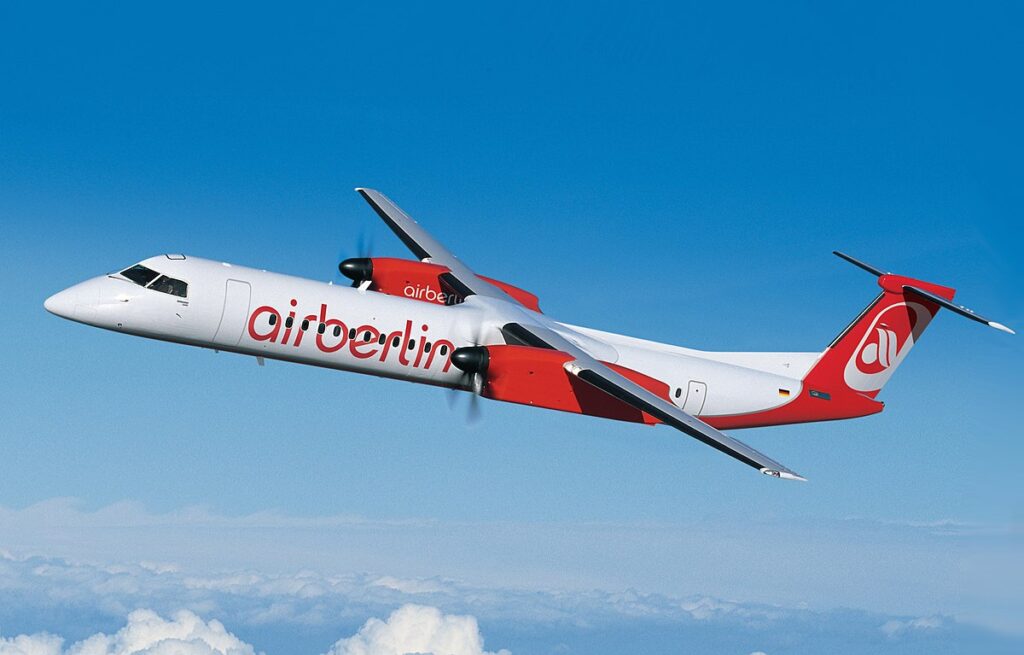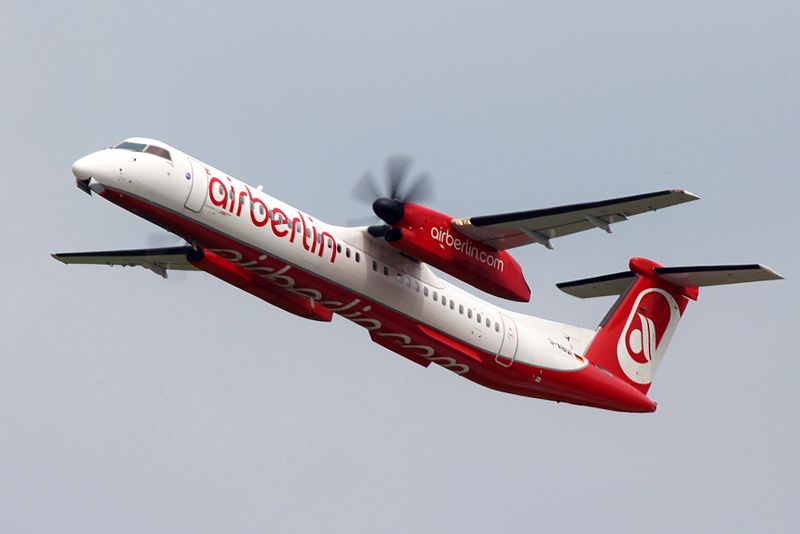Dash 7 (DHC-7) vs Dash 8 (DHC-8) is a debate in the world of regional aircraft. Here is the guide to the cost, performance, and seating capacity of both planes.
De Havilland Canada manufactured the two most popular models of aircraft. These are the Dash 7 (DHC-7) and Dash 8 (DHC-8). Both aircraft have different goals. Thus, the Dash 7 is the best choice for companies that give services for short-hour flights. However, the Dash 8 is the choice of airlines that want more efficient services.
Let’s get started with a detailed overview of the Dash 7 and Dash 8 regional aircraft.

Overview: Dash 7 (DHC-7) vs Dash 8 (DHC-8)
The De Havilland introduced its model Dash 7 (DHC-7) in 1975. Soon after the launch, it became famous for its STOL performance. Actually, STOL means short takeoff and landing. Thus, this plane can reach remote airports, which are ignored by larger airports.
The Dash 7 has four Pratt and Whitney PT6A-50 engines. Thus, it provides enough power to take off from runways as short as 2,200 feet. Following Airlines use this regional jet,
- Canadian Forces
- Venezuelan Navy
- US Army
In contrast, De Havilland introduced its model Dash 8 (DHC-8) in 1984. The company claimed that it could provide higher-capacity regional flights. Thus, there are many new models of Dash 8.
For example, the Dash 8 Q400 is the most advanced model of the Dash 8 series. Thus, it can carry up to 78 passengers.
Also, there is higher fuel efficiency, comfort, and modern technology in Dash 8. So, the airlines choose Dash 8, which provides services for short to medium-hour flights.
The following Airlines use the DASH 8 (DHC-8):
- WestJet Encore (Canada)
- Horizon Air (U.S., a subsidiary of Alaska Airlines)
- QantasLink (Australia)
- Air Canada Express (Canada)
- Porter Airlines (Canada)
Dash 7 (DHC-7) vs Dash 8 (DHC-8) is a battle of regional aircraft because there are major differences between these planes.
Key Differences: Dash 7 vs Dash 8
1. Capacity and Passenger Comfort
There is a difference in seating capacity and passenger comfort.
Dash 7 (DHC-7) can carry 48 to 54 passengers. Also, It is primarily useful for short-range flights. Moreover, it focuses on efficient services rather than luxury. So, for luxury-seeking travelers or airlines, it is not a better option.
Dash 8 (DHC-8) Capacity has more flexibility in seating arrangement. The passenger capacity is different for each Dash 8 model.
For example, The Dash 8-100 can carry 37 passengers. However, the newer model Dash 8 Q400 can accommodate up to 78 passengers.
Also, the Dash 8 series focuses on utility rather than the luxury of passengers. This makes the Dash 8 ideal for regional airlines that have a high number of passengers.
The Dash 8 also includes advanced noise-reduction technology (known as Active Noise and Vibration Suppression or ANVS). So, it enhances the comfort of passengers.
2. Engine Configuration and Performance: Dash 7 (DHC-7) vs Dash 8 (DHC-8)
The Dash 7 and Dash 8 have different engine configurations. So, there is a difference in the performance of jets.
The Dash 7 uses four Pratt & Whitney PT6A-50 engines. These engines provide the power for short-range flights. Thus, these planes can easily take off and land on smaller airports.
Dash 8 Engines uses two Pratt & Whitney PW150A engines. These engines are highly efficient. Thus, they have higher cruising speed and longer range compared to the Dash 7.
The Dash 7’s STOL performance makes it well-suited for short, tough runways.
But the Dash 8 is a more efficient engines that provide a longer range and better fuel economy. Hence, this makes it a better fit for commercial airlines that prioritize cost efficiency.
3. Range and Speed
The Dash 7 has a maximum range of about 890 km. Also, It is a relatively short-range aircraft. Thus, primary destinations include remote locations where longer runway space is unavailable. Moreover, the cruising speed is 428 km/h, which is lower than that of Dash 8.
The Dash 8 Q400 has a much longer range and can cover 2,500 km. This makes it a more versatile aircraft that is best suited for a wider variety of regional routes. In addition, the Dash 8 Q400 has a cruising speed of 667 km/h, which is greater than that of the Dash 7.
4. Price Comparison: Dash 7 (DHC-7) vs Dash 8 (DHC-8)
The Dash 7 is more affordable. The reason is that it is an older model. However, the cost may increase in some cases, such as the issues of higher maintenance. So, the estimated price for a used Dash 7 is between $5 to $10 million.
On the other hand, the Dash 8 is significantly more expensive. The reason is its newer technology, larger size, and higher performance. However, the price may be for each Dash 8 model.
A new Dash 8 Q400 costs between $25 to $32 million. Older models like the Dash 8-100 or Dash 8-300 are less expensive.
Let’s look at the comparison table.
| Feature | Dash 7 (DHC-7) | Dash 8 (DHC-8) |
| Passenger Capacity | 48-54 | 37-78 (depending on variant) |
| Maximum Range | 890 km | 2,500 km (Q400) |
| Cruising Speed | 428 km/h | 667 km/h (Q400) |
| Engines | 4x Pratt & Whitney PT6A-50 | 2x Pratt & Whitney PW150A |
| Operational Role | Remote areas, short runways | Regional routes, high capacity |
| Price Range | $5 to $10 million | $25 to $32 million |
Pros and Cons: Dash 7 (DHC-7) vs Dash 8 (DHC-8)
Dash 7 (DHC-7)
Pros:
- Excellent for short runways and challenging airport environments.
- Robust and durable design in various weather conditions.
- Lower Passenger Capacity
Cons:
- Limited Range compared to the Dash 8.
- Higher maintenance Costs
Dash 8 (DHC-8)
Pros:
- Higher Capacity to accommodate a larger number of passengers.
- Suitable for a broader range of routes.
- Better Fuel Efficiency
- Modern technology for better operational efficiency.
Cons:
- Less STOL (Short Takeoff and landing) Efficiency
- Higher Price
Final Verdict
The Dash 7 (DHC-7) vs Dash 8 (DHC-8) is not a problem when Airlines know about the travel needs. So, in the case of short runways, then Dash 7 is the best choice. However, if there are longer routes, the Dash 8 provides ideal services. Moreover, airlines should think about their customers carefully. This will help to choose the best cost-effective regional plane.


FAQs
What are the primary operational differences between the Dash 7 and Dash 8?
The Dash 7 is designed for short takeoff and landing (STOL) operations. So, it is suitable for airports with limited facilities, while the Dash 8 offers a longer range and higher passenger capacity, making it ideal for regional routes. The Dash 8 also benefits from improved fuel efficiency and advanced avionics compared to the Dash 7.
Which aircraft is more economical for regional airlines?
The Dash 8 is generally considered more economical for regional airlines due to its larger passenger capacity and operational efficiency, especially the Q400 variant, which offers faster cruising speeds and lower operating costs compared to the Dash 7.
What are the maintenance requirements for both aircraft?
The Dash 7 typically requires more maintenance due to its older design and STOL capabilities, while the Dash 8, particularly the newer variants, features modern systems that can reduce maintenance downtime and costs.

